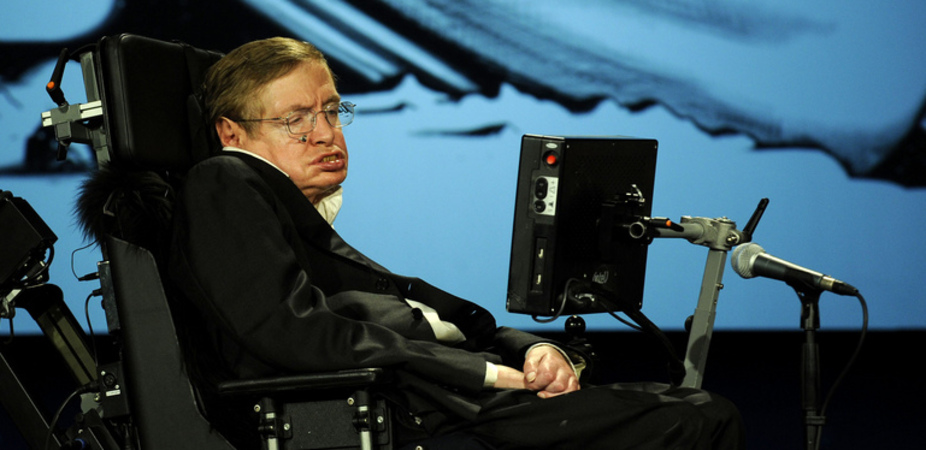
Humanity should focus its efforts on exploring other worlds that we might inhabit, and to get there, Earthlings may need to ride on a beam of light, famed physicist Stephen Hawking says.
Hawking made his remarks today (June 20) at Starmus, an arts and science festival in Norway whose advisory board he sits on. In his speech, he reiterated his belief that humans need to explore space to avoid the dangers of our own finite world. And then he described how humans could one day travel on a beam of light, harnessing the power of Einstein's theory of relativity to reach mind-bogglingly distant planets. [8 Shocking Things We Learned from Stephen Hawking's Book]
Earth in peril
The human imagination has led us to peer ever deeper into the universe with scientific tools, Hawking said. Yet despite this ability to investigate the most distant reaches of the universe without leaving our backyards, humans shouldn't be content with this sedentary approach.
"Shouldn't we be content to be cosmic sloths, enjoying the universe from the comfort of Earth? The answer is, no," Hawking said in his address. "The Earth is under threat from so many areas that it is difficult for me to be positive."
What's more, humans are naturally curious explorers who are driven to push into the unknown. Hawking described the looming threats of a too-crowded world facing climate change, the collapse of animal species and the draining of physical resources. (Hawking has previously mentioned his conviction that humanity is doomed in the next millennium unless people can come up with an escape plan.)
"When we have reached similar crises in our history, there has usually been somewhere else to colonize. Columbus did it in 1492 when he discovered the New World. But now there is no new world. No Utopia around the corner," Hawking said.
Explore the unknown
The easiest targets are the places closest to home: the moon and Mars, Hawking said in his Starmus address. The moon is nearby, but it's small, has no liquid water and lacks a magnetic field to shield people from radiation. Mars may once have had liquid water and an atmosphere, but no longer.
Get the world’s most fascinating discoveries delivered straight to your inbox.
But an even more promising idea is to explore some of the planets in the vicinity of our nearest stellar neighbor, Proxima Centauri, at a distance of about 4.5 light-years from Earth, where 1 light-year is nearly 6 trillion miles (10 million kilometers). A planet circling Proxima Centauri, called Proxima Centauri b, may be somewhat similar to Earth, at least in a few respects, Hawking said.
However, we'll never know how hospitable Proxima b is unless we can get there. At current speeds, using chemical propulsion, it would take 3 million years to reach the exoplanet, Hawking said. [Interstellar Space Travel: 7 Futuristic Spacecraft to Explore the Cosmos]
Thus, space colonization requires a radical departure in our travel technology.
"To go faster would require a much higher exhaust speed than chemical rockets can provide — that of light itself," Hawking said. "A powerful beam of light from the rear could drive the spaceship forward. Nuclear fusion could provide 1 percent of the spaceship's mass energy, which would accelerate it to a tenth of the speed of light."
Going faster than that would require harnessing matter-antimatter annihilation or as-yet-undreamed-of technology, he added. (When matter and antimatter come into contact, they annihilate, releasing gobs of energy.)
Tiny space probes
To bring these seeming pipe dreams closer to reality, Hawking, along with physicist and billionaire Yuri Milner, has founded a company called Breakthrough Starshot, which aims to make interstellar travel a reality. As an early prototype, the team is creating a teensy space probe, just a few centimeters wide, attached to a miniscule light sail. The plan is to send 1,000 of these "StarChips" and their sails into the void, with arrays of lasers uniting to form one powerful light beam to propel the tiny sails with gigawatts of power, Hawking said.
The energy imparted to the tiny space probes could zoom them to speeds reaching about 100 million mph (160 million km/h), which would mean they would reach Mars in a day (as opposed to 260 days using propulsion). At one-fifth the speed of light, the probes would reach Alpha Centauri in just 20 years and send images of any possible planets back on another light beam, Hawking said. Another physicist, Claudius Gros has proposed using these tiny space explorers to colonize far-flung planets with a biosphere of unicellular organisms, Hawking said
"Human colonization on other planets is no longer science fiction. It can be science fact. The human race has existed as a separate species for about 2 million years. Civilization began about 10,000 years ago, and the rate of development has been steadily increasing. If humanity is to continue for another million years, our future lies in boldly going where no one else has gone before," Hawking said.
Originally published on Live Science.

Tia is the editor-in-chief (premium) and was formerly managing editor and senior writer for Live Science. Her work has appeared in Scientific American, Wired.com, Science News and other outlets. She holds a master's degree in bioengineering from the University of Washington, a graduate certificate in science writing from UC Santa Cruz and a bachelor's degree in mechanical engineering from the University of Texas at Austin. Tia was part of a team at the Milwaukee Journal Sentinel that published the Empty Cradles series on preterm births, which won multiple awards, including the 2012 Casey Medal for Meritorious Journalism.


